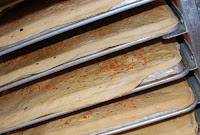Spring Break is a much needed respite after the hibernation period of winter. The warmer weather outside and the longer days due to Daylight Savings Time (originally implemented to conserve coal during wartime) cause students’ (and adults’) attention to wander. For our Spring Break this year, we vacationed at the
Ritz-Carlton in Palm Beach, Florida.
 |
| Club Room nibbles |
The hotel is absolutely gorgeous with a sumptuous lobby area, three upscale restaurants and a pool overlooking incredibly blue water of the Atlantic Ocean. We treated ourselves and opted to stay on the Club level to take advantage of continental breakfasts, lunchtime nibbles, hors d'œuvres during the cocktails hours and dessert and cordials after the dinner hour.
 |
| Vivian's Lollies |
One evening, we ate at the hotel’s anchor restaurant
“Angle,” where we had delicious meals, excellent service and a surprise treat for dessert. Our waitress brought out what looked like a table decoration that turned out to be free-form chocolate lollipops. These treats were made with dark chocolate served on skewers. “Don’t just gobble them down,” the waitress hinted, “you need to savor them.” That’s when we noticed it – subtle at first, but a sparkling sensation. Rice Crispies? No, Pop Rocks!
The next day, I wheedled my way into an invitation to the hotel’s main kitchen with the main goal of finding out how to make those pops. (Thanks Phillip!) I felt like a celebrity with a back stage pass! (Thanks
Chef Artim!) Surprisingly, the facilities were far smaller than I imagined, but an amazing volume of food was being prepared for the three on-site restaurants as well as the Club level and room service.
I was introduced to Vivian Hussein who patiently explained the steps she took to
temper the chocolate, when to add the pop rocks and how to assemble the lollies. So armed with her recipe and tutelage, we headed home. The next day, I headed straight to the one store I knew would have Pop Rocks –
Michael’s. Pop Rocks are a carbonated candy made by heating the ingredients until they melt into a dust, and then exposing the mixture to pressurized carbon dioxide gas and allowing it to cool. This process causes tiny, high-pressure bubbles to be trapped inside the candy so that it creates a “fizzing” reaction when it dissolves in your mouth.

Vivian’s explanation of how to temper the chocolate made the process sound easy, however, I was still quite intimidated by the idea of actually doing it myself. While at Michael’s I also found bags of
Wilton’s melting chocolates which needed no tempering - Jackpot!! I quickly paid the cashier and dashed home to play!
Chocolate Pop Rock Lollipops- 1/3 cup Wilton Dark Cocoa Candy Melts®
- 1 pack Pop Rocks (or more!)
- Chocolate transfer sheets (if available) or parchment paper
- Microwave safe bowl
- Bamboo skewers
Before you begin, make sure all of your utensils are dry. Water causes melted choclate to harden and streak. Lay your chocolate transfer sheets (or a piece of parchment paper) on a cookie sheet. We used the back of a half sheet pan so the skewers lay flat. Then in a Ziploc bag, microwave the chocolate at half power or the defrost setting for 30 seconds. Massage the chocolate in the bag (if you can – after the first 30 seconds, ours were still too solid to stir.) Continue to microwave at 30-second intervals and mix until the chocolate is smooth and completely melted. When ready, the chocolate should be the consistency of cooked pudding.

Next, add the pack of Pop Rocks to the melted chocolate in the Ziploc bag and and mix gently so you don’t crush the rocks. When mixed together thoroughly, cut one of the corner of the bag to form a makeshift pastry bag. Make the cut large enough to allow rocks to pass through but not too huge because, unlike frosting, the chocolate will flow pretty quickly from the bag. Use the bag to make tablespoon-sized shapes on the transfer/parchment paper. You can also use a teaspoon to drop spoonfuls of the chocolate on the transfer/parchment paper. Use the spoon to gently (again not to crush rocks) spread the chocolate upward to make your desired shape.

Lay a skewer in the back of the pop and press gently; rotating slightly to make sure it is coated in chocolate and well attached. Then set the sheet pan aside until the chocolate is set. Resist the urge to place in the freezer since pops may weep and cause rocks to fizz. Gently remove the lollipops from the transfer sheet or parchment.
Lay a skewer in the back of the pop and press gently; rotating slightly to make sure it is coated and well attached. Then lay the sheet pan in the freezer until the chocolate is set. Gently remove the lollipops from the transfer sheet or parchment.
The lollies were then placed in a flower vase and served at a dinner party. Laughter arose from the table when everyone figured out the mystery ingredient!
 Sudachi Margarita
Sudachi Margarita 



























